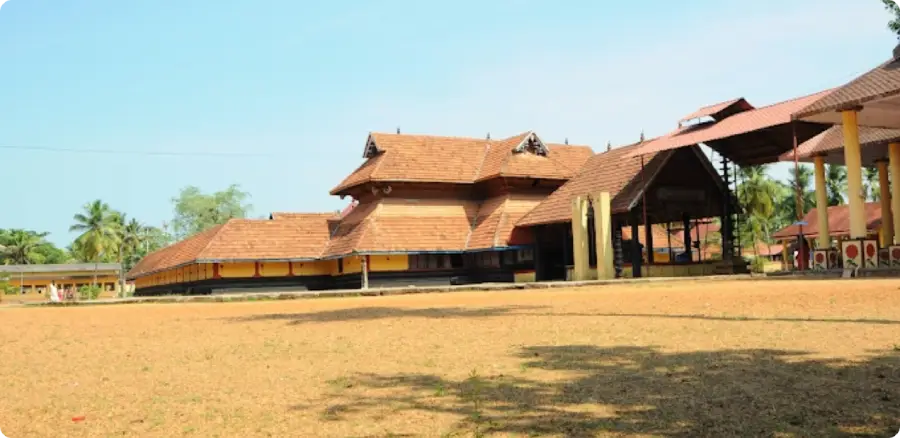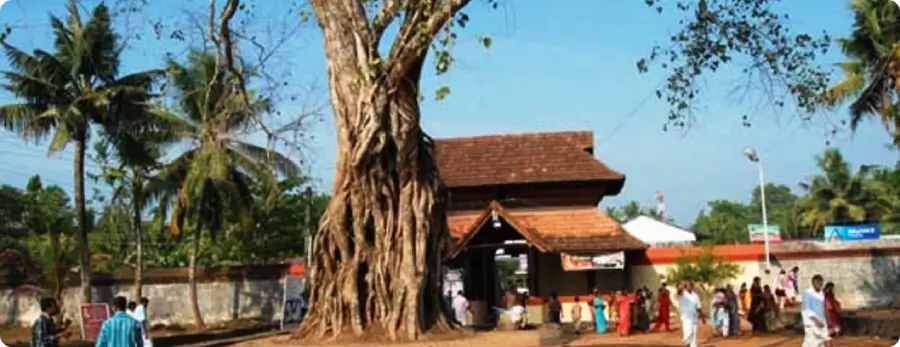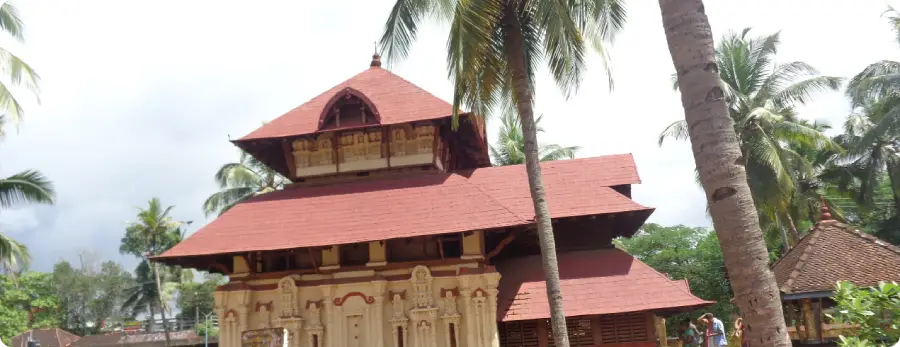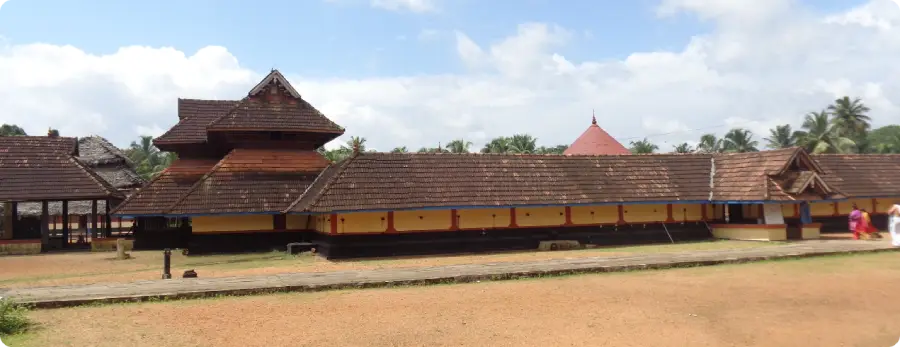Thrikkuratti Mahadeva Temple

Introduction to Thrikkuratti Mahadeva Temple
- Distance from Alappuzha railway station: 40 KM
- Distance from Alappuzha Bus stand: 41 KM
- Distance from Alappuzha Boat Jetty: 41 KM
In the heart of Mannar, Alappuzha, Kerala, lies the Thrikkuratti Mahadeva Temple, a sacred enclave that whispers tales of divinity and architectural splendor from the ancient past. Perched gracefully along the banks of the Pampa river, this venerable temple is a sanctuary dedicated to Lord Shiva, revered by devotees for centuries. It is not just a place of worship but a beacon of Kerala’s profound spiritual heritage, embodying the essence of tranquility and divine presence.

The Thrikkuratti Mahadeva Temple is celebrated as one of the 108 Shiva temples in Kerala, a distinction that underscores its significance in the spiritual tapestry of the region. According to legend, the temple’s origins are linked to sage Parashurama, a pivotal figure in Hindu mythology, who is said to have installed the idol of Shiva. This ancient edifice, with its traditional Kerala architectural motifs, stands as a testament to the architectural grandeur of yesteryears, inviting all who seek solace and spiritual awakening within its sacred precincts.
The Historical Saga of Thrikkuratti Mahadeva Temple
Ancient Origins and Mythical Foundations
Nestled on the tranquil banks of the Pampa river, the Thrikkuratti Mahadeva Temple’s origins are steeped in legend and spirituality. Believed to be over 500 years old, this sacred edifice is said to have been established by the legendary sage Parashurama, a key figure in Hindu mythology known for creating Kerala. The temple is enshrined within the revered list of the 108 Shiva temples in Kerala, marking it as a pivotal site of worship in the spiritual landscape of the state. The myths surrounding its inception weave a rich tapestry of devotion, with tales of divine intervention and celestial blessings contributing to its sanctity and significance.
Architectural Marvels and Divine Constructions
The Thrikkuratti Mahadeva Temple is a masterpiece of traditional Kerala-style architecture, distinguished by its open-roof sanctum sanctorum that invites the heavens into its sacred space. This architectural choice reflects a profound connection between the divine and the devotees, symbolizing an unobstructed pathway for spiritual communion. Adding to the temple’s mystique is the mammoth compound wall, which legend says was constructed overnight by the Bhootas of Lord Paramasiva. This feat is not just a testament to the divine powers at play but also highlights the temple’s significance as a divine construct, protected and blessed by Lord Shiva himself. The temple’s architecture and the stories behind its constructions continue to awe and inspire, drawing devotees and history enthusiasts alike to marvel at its grandeur and divine legacy.

Architectural Splendor and Sacred Ensemble at Thrikkuratti Mahadeva Temple
Kerala’s Architectural Elegance
The Thrikkuratti Mahadeva Temple, nestled on the serene banks of the Pampa river, is a quintessential example of Kerala’s architectural magnificence. This ancient edifice is crafted in the traditional Kerala-style architecture, renowned for its harmonious blend of beauty and spirituality. The temple’s structure, with its majestic gopuram (gateway tower), sloping tiled roofs, and an open-roof sanctum sanctorum, reflects the artistic finesse that Kerala architecture is celebrated for. The open ceiling of the sanctum sanctorum invites divine energy directly from the heavens, symbolizing an unbroken connection between the devotee and the divine. Intricate wood carvings and mural paintings adorn the walls, each telling tales of mythological lore and embodying the rich cultural heritage of Kerala.
Pantheon of Deities
Within the sacred precincts of Thrikkuratti Mahadeva Temple resides a diverse ensemble of deities, making it a vibrant center for multi-deity worship. The primary deity, Lord Shiva, revered in the form of Mahadeva, presides in solemn splendor, offering solace and blessings to all who seek his divine grace. Accompanying him are other revered figures from the Hindu pantheon, including Lord Ganesh, the remover of obstacles; Lord Hanuman, the embodiment of devotion and strength; and the serpent deities, guardians of the temple’s sanctity. This sacred ensemble underscores the temple’s inclusive spiritual ambiance, welcoming devotees of various deities to come together in a shared space of worship and reverence. The Thrikkuratti Mahadeva Temple thus stands as a testament to the spiritual diversity and architectural brilliance that Kerala proudly upholds.

Festivals of Faith and Devotion at Mullakkal Rajarajeswari Temple
Mullakkal Chirappu: A Spectacle of Divine Celebration
The Mullakkal Chirappu stands as a testament to the vibrant cultural and spiritual fabric of Kerala, celebrated with fervor at the Mullakkal Rajarajeswari Temple. This 41-day festival transforms the temple premises into a hub of devotion, attracting thousands from near and far. The air resonates with the rhythmic beats of traditional music as the temple and its surroundings are adorned with lights and decorations, creating a mesmerizing atmosphere. The highlight of the festival includes grand elephant processions, where these majestic beings, caparisoned in their finery, carry the deity, symbolizing the royal respect and honor bestowed upon the divine. Cultural programs featuring classical dance, music, and theatrical performances narrate tales of gods and goddesses, enriching the spiritual experience. The Mullakkal Chirappu culminates in an elaborate display of fireworks, marking the zenith of this divine celebration, leaving an indelible mark on the hearts of devotees and tourists alike.
Visitors Guide To Thrikkuratti Mahadeva Temple
Planning Your Pilgrimage
- Temple Timings: Open from 5:00 AM to 8:00 PM, allowing devotees to partake in both morning and evening rituals.
- Best Times to Visit: The temple is especially vibrant during the Maha Shivaratri and Navaratri festivals. However, the pleasant weather from October to March makes it an ideal time for a visit.
- Visitor Etiquette: Devotees are encouraged to dress modestly in traditional attire. Adherence to temple protocols, such as removing footwear before entering the sanctum, is expected to maintain the sanctity of the temple.
Navigating to the Sacred
- By Air: The nearest airport is Cochin International Airport, approximately 100 km away, with regular taxi and bus services to Mannar.
- By Train: The closest railway station is in Alappuzha, around 40 km from the temple, offering convenient connections.
- By Road: Mannar is well-connected by road, with frequent bus services from major cities in Kerala, making the temple easily accessible.
Accommodations and Amenities
- Staying Near the Divine: A range of accommodations is available near Thrikkuratti Mahadeva Temple, from budget lodges to luxury resorts, catering to all preferences and budgets. Many of these offer traditional Kerala cuisine and comfortable amenities.
- Facilities for Devotees: The temple vicinity is equipped with basic amenities such as clean water, restrooms, and small eateries. During festival times, additional facilities like medical camps and security are provided to ensure a safe and spiritual experience for all visitors.
Conclusion
Embracing the serene and divine ambiance of Thrikkuratti Mahadeva Temple, nestled by the Pampa river in Mannar, Alappuzha, is a journey into the heart of Kerala’s spiritual heritage. This ancient sanctuary, dedicated to Lord Shiva, stands as a testament to the profound spirituality and rich cultural traditions that Kerala proudly upholds. With its traditional Kerala architecture and the sacred backdrop of the Pampa river, the temple offers a tranquil retreat for devotees and tourists alike. Celebrated for its grand observances of Maha Shivaratri and Navaratri, Thrikkuratti Mahadeva Temple invites all to partake in its spiritual practices and experience the divine blessings. As a beacon of divine sanctuary and cultural heritage, it continues to inspire and offer solace to those seeking spiritual fulfillment amidst the serene beauty of Kerala.